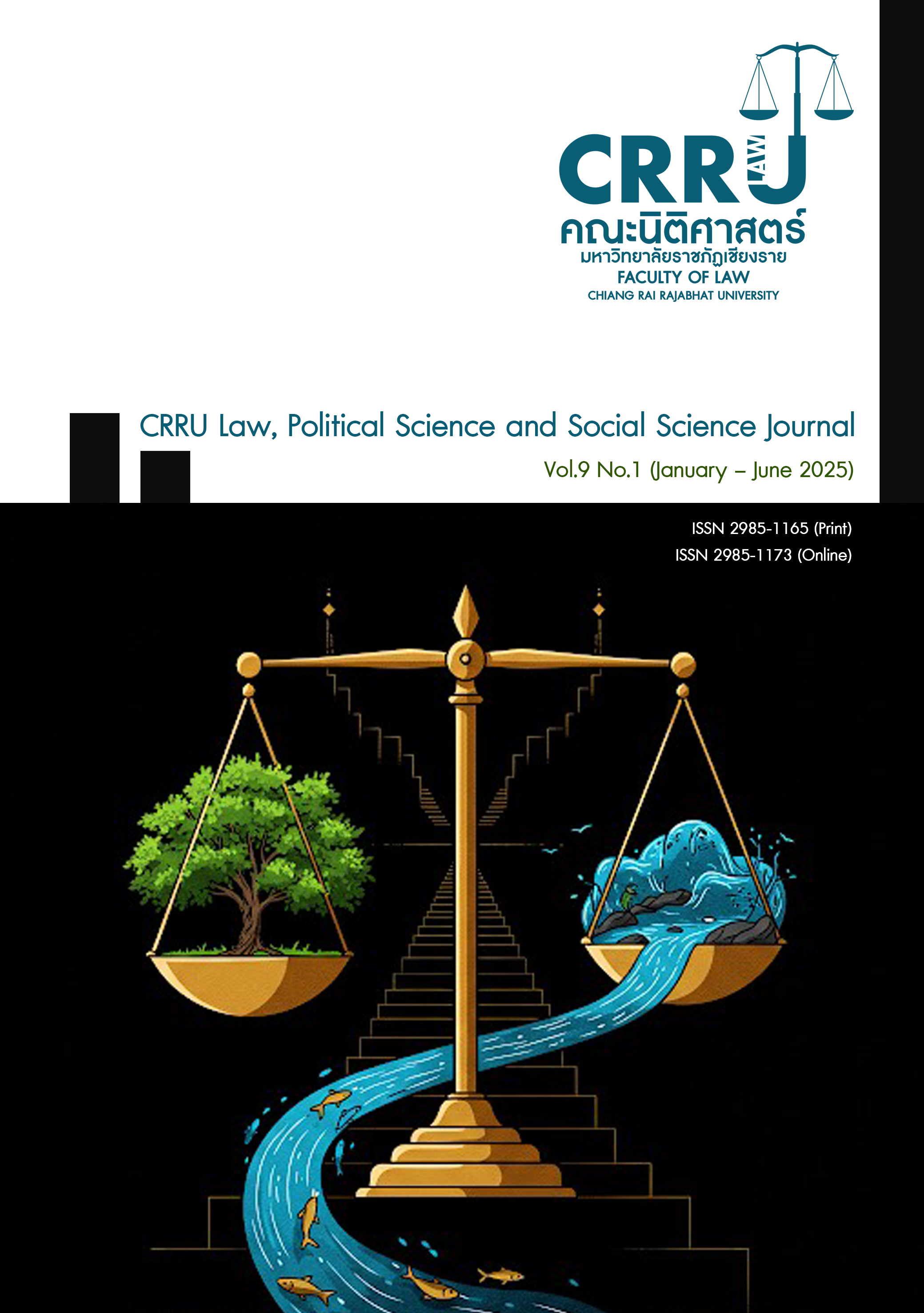Problems and obstacles in Legal matters regarding solving informal debt related to borrowing money
Main Article Content
Abstract
The purposes of this research article are to 1) study the concepts, theories, and laws related to informal debt; 2) study the problems and obstacles in Legal matters regarding solving informal debt related to borrowing money; and 3) Analyze approaches to solving the problem of informal debt in an integrated and sustainable manner. The research results found that the cause of the informal debt problem is that the Thai economic outlook in 2023 will expand at a slower rate, which (1) affects Thai exports, which are the country's main source of income; and (2) affects people's lives and becomes a social problem because of insufficient income, causing people to urgently spend money but cannot access formal sources of funds. They have to enter into a large amount of informal debt, resulting in the informal debt problem, which is caused by two issues: (a) informal creditors have taken advantage of debtors by charging interest rates higher than the law, which is a violation of the provisions of the law; and (b) informal creditors have used intimidation and violence to collect debts, which is a method that violates the law. The actions of these two main issues of informal creditors are considered unfair to debtors. Therefore, this research proposes solutions to the informal debt problem as follows: 1) The government must strictly use legal measures to punish creditors; 2) The government should focus on supporting various forms of funding sources. to the people 3) The government should support job creation so that people can use the money to pay off their debts by themselves 4) The government should support communities to participate in solving problems at the grassroots level seriously and 5) There should be integration to solve problems systematically from the government, civil society and private sectors. There should be a main agency responsible for analyzing problems and creating policies at the national level to lead to implementation and follow up and evaluate the results to ensure clarity, continuity and efficiency in all dimensions.
Article Details
References
กานดา ภู่เชี่ยวชาญวิทย์. “การบังคับใช้กฎหมายห้ามเรียกดอกเบี้ยเกินอัตรา.” วิทยานิพนธ์ปริญญานิติศาสตรมหาบัณฑิต คณะนิติศาสตร์ จุฬาลงกรณ์มหาวิทยาลัย, 2528.
ชนิดาภา บุญญาภิสมภาร. “พระราชบัญญัติห้ามเรียกดอกเบี้ยเกินอัตรา พุทธศักราช 2560 ที่มีการแก้ไขกับพระราชบัญญัติห้ามเรียกดอกเบี้ยเกินอัตรา พุทธศักราช 2475.” จุลสารศาลฎีกา 4, ฉ.2 (เมษายน – มิถุนายน 2560): 14-15.
ไชยยศ เหมะรัชตะ. กฎหมายว่าด้วยสัญญา. พิมพ์ครั้งที่ 3. กรุงเทพมหานคร: จุฬาลงกรณ์มหาวิทยาลัย, 2547.
ณัฐพงศ์ พันธุ์ไชย. การศึกษาปัญหาของมาตรการสินเชื่อนาโนไฟแนนซ์ (Nano-Finance) ในการแก้ไขปัญหาหนี้นอกระบบของไทย. กรุงเทพมหานคร: สถาบันพระปกเกล้า, 2565.
ดาราพร ถิระวัฒน์. กฎหมายสัญญา สถานะใหม่ของสัญญาปัจจุบันและปัญหาข้อสัญญาไม่เป็นธรรม. พิมพ์ครั้งที่ 2. กรุงเทพมหานคร: มหาวิทยาลัยธรรมศาสตร์, 2542.
ไทยรัฐออนไลน์. “รัฐบาล ลุยสางปัญหาหนี้นอกระบบ ช่วย ปชช.ครอบคลุมทุกมิติ.” 2563. https://www.thairath.co.th/news/politic/1928991. สืบค้นเมื่อ 25 ธันวาคม 2566.
ธนาคารแห่งประเทศไทย. “รายงานภาวะเศรษฐกิจไทย ปี 2566.” 2566. https://www.bot.or.th/content/dam/bot/documents/th/thai-economy/state-of-thai-economy/annual-report/annual-econ-report-th-2566.pdf. สืบค้นเมื่อ 7 ธันวาคม 2566.
ประเสริฐ เสียงสุทธิวงศ์. คำพิพากษาศาลฎีกา พุทธศักราช 2562 เล่มที่ 6. กรุงเทพมหานคร: สำนักงานศาลยุติธรรม, 2562.
ไผทชิต เอกจริยกร. “ปัญหาหนี้นอกระบบในสังคมไทย.” วารสารราชบัณฑิตยสถาน 16, ฉ.1 (มกราคม - มีนาคม 2556): 14-30.
พัฒน์วิภา กังวานโสภณ. “ผลของการเรียกดอกเบี้ยเกินอัตราที่กฎหมายกำหนดตามมาตรา 654 แห่งประมวลกฎหมายแพ่งและพาณิชย์.” 2566. https://bsru.net/ผลของการเรียกดอกเบี้ย. สืบค้นเมื่อ 21 เมษายน 2566.
มูลนิธิเพื่อผู้บริโภค. “หนี้นอกระบบ ตอนที่ 1.” 2567. https://www.consumerthai.org/menutd3/2950-1-316.html. สืบค้นเมื่อ 6 เมษายน 2567.
ยุวดี มัญติยาการกุล. คำอธิบายกฎหมายลักษณะหนี้. ศรีสะเกษ: บริษัท สำนักพิมพ์พานทอง จำกัด, 2564.
รวิวรรณ สาลีผล. ประวัติของเศรษฐกิจไทยตั้งแต่ปี 2475. กรุงเทพมหานคร: สำนักวิชาเศรษฐศาสตร์และนโยบายสาธารณะ มหาวิทยาลัยศรีนครินทรวิโรฒ, 2555.
วิชัย สุวรรณประเสริฐ. “หนี้นอกระบบกับความเปลี่ยนแปลงทางสังคมและกฎหมาย.” ดุลพาห 64, ฉ.2 (พฤษภาคม - สิงหาคม 2560): 99.
วันชัย มีชาติ และคณะ. โครงการศึกษาพัฒนานโยบายการยุติธรรมเพื่อแก้ปัญหาหนี้นอกระบบ. (รายงานการวิจัย). กรุงเทพมหานคร: จุฬาลงกรณ์มหาวิทยาลัย. 2566, 57.
สถาบันวิจัยสังคม จุฬาลงกรณ์มหาวิทยาลัย. โครงการศึกษาพัฒนานโยบายการยุติธรรมเพื่อแก้ปัญหาหนี้นอกระบบ. (รายงานการวิจัย). กรุงเทพมหานคร: จุฬาลงกรณ์มหาวิทยาลัย. 2566, 57.
สุนีย์ มัลลิกะมาลย์ และคณะ. วิวัฒนาการของกฎหมายไทยในรอบสองร้อยปี ภาค 5: ภาคกฎหมายมหาชนส่วนแพ่งหรือกฎหมายสังคม. (รายงานการวิจัย). กรุงเทพมหานคร: จุฬาลงกรณ์มหาวิทยาลัย. 2525, 256.
สำนักงานสถิติแห่งชาติ. “การสำรวจภาวะเศรษฐกิจและสังคมของครัวเรือนพ.ศ.2566.” 2566. https://www.nso.go.th/nsoweb/storage/survey_detail/2024/20240402152717_24633.pdf. สืบค้นเมื่อ 6 เมษายน 2567.
สำนักวิชาการ สำนักงานเลขาธิการสภาผู้แทนราษฎร. “กฎหมายติดตามทวงถามหนี้อย่างเป็นธรรม: กฎหมายความหวังของลูกหนี้.” 2557. http://www.parliament.go.th/library. สืบค้นเมื่อ 30 เมษายน 2566.
สุรางค์รัตน์ จำเนียรพล. หนี้นอกระบบกับความเป็นธรรมทางสังคม. กรุงเทพมหานคร: สถาบันวิจัยสังคม จุฬาลงกรณ์มหาวิทยาลัย, 2557.


